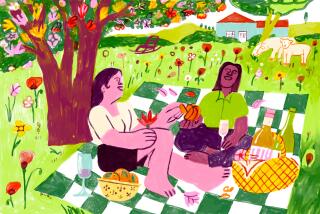Italy’s wine returns to local roots
- Share via
MONTEROSSO, ITALY — Vittorio Cavallo crouched in his vineyard on a terraced slope overlooking the sea. He was shaded by a thick canopy of vines, plump bunches of grapes hanging like mini-chandeliers. In a couple of days, he and his family would launch the vendemmia -- the harvest.
The small, delicate grape that Cavallo raises will go to make a rare sweet wine that is available only in this northern corner of Italy, one so precious, he said, that “you give a bottle to the doctor so he’ll take better care of you.”
Cavallo is part of a growing movement across Italy to return to native grapes, eschewing the tastes of the international mass market and embracing a regional-based tradition of winemaking that goes back thousands of years.
But like the wine industry as a whole, these old-style producers face a gusher of modern-day challenges, including European Union restrictions, high costs and global warming’s effect on the way grapes are harvested.
“We call it heroic viticulture,” said Matteo Bonanini, head of a cooperative of grape growers here in the Cinque Terre region. “You have to be really dedicated.”
Bonanini was overseeing the delivery of hundreds of pounds of freshly picked pale-green grapes to the co-op’s press. Gentlemen farmers arrived with grape-packed crates tied to the roofs of their Fiats, while miniature pickup trucks hauled in more of the harvest in a land so steep and craggy that even mules cannot navigate some of the cliff-clinging vineyards, or so the locals say.
Grapes were being poured into the press, enzymes added and the liquid stored for fermentation. Gigantic wasps flitted about the bunches of fruit, and a farmer occasionally plucked a grape and popped it into their mouth, like people do in the olive-and-nut section of a supermarket.
Few in this panorama of green cliffs and blue bays, known as Italy’s Riviera, can make a living as vintners, so they tend their patches and harvest grapes as a sideline, “a passion, not a job,” Bonanini said.
His Cinque Terre co-op will produce only about 200,000 bottles of the region’s eponymous crisp, white wine, of which 2,400 bottles will be exported to California. Sciacchetra, the rare sweet wine that he, Cavallo and a few others concoct, will not leave these shores, at least not in any significant quantity. It is “in a league of its own,” Bonanini said.
That these spirits are being bottled at all is perhaps a viticultural miracle, testimony to an important shift over the last decade in Italy, the world’s second-largest wine producer and home to more grape varieties than anyplace else on the planet.
Wine has been produced in this region for millenniums. The Romans made wine 2,000 years ago, the Etruscans before them.
For most of those centuries, the Italians relied on the land and climate -- with little emphasis on technology -- to yield cheap-ish Chiantis, Frascatis and other reds and whites. In the latter part of the 20th century, they began adapting their techniques and transformed Italy into a major exporter of quality wine.
At the same time, however, scores of Italian winemakers abandoned native grapes and planted imported varieties such as chardonnay and merlot. They were following the fads of the day, obeying the whims of influential wine critics.
Lost were distinctive regional wines and a measure of rich Italian identity. Eventually, Italian vintners found it difficult to compete with “New World” producers such as South Africa and Chile, which could make chardonnay more cheaply.
And so many Italian vintners began returning to their roots, practicing a craft they say synthesizes the soil, the climate and the personality of the farmer.
“All over Italy, there is a reevaluation of native varieties that is very encouraging,” Burton Anderson, a leading expert and author on Italian wine, said from his home in Tuscany.
“There is more and more interest in the world in new tastes and regional dishes from Italy,” Anderson said. “It is stimulating people who are tired of the standardization that took place for so long.”
As examples, he cited the surge in the Nero d’Avola grape from Sicily and the Aglianico from the Campania region -- even Tuscany’s Sangiovese grape, which has been cloned into a premium variety used in the best fermentations. All made comebacks or were given a new lease on life in the oenological world.
In Cinque Terre, vintners use an exact formula that combines indigenous Bosco, Vermentino and Albarola fruits.
This kind of winemaking is not easy, nor is it inexpensive, Anderson and others said. It requires meticulous processing, careful cloning of vines, and sales and promotion in markets that may be obsessed with a few familiar names.
Added to that are new challenges.
This summer, the European Union proposed a major overhaul to the continent’s $15-billion, heavily subsidized wine sector, with the goal of reducing a glut of wine and making the business more competitive. In Europe, imports are growing faster than exports; the EU spends hundreds of thousands of dollars a year to buy unsalable wine and convert it to ethanol and other industrial products.
Among the EU’s proposals: paying growers to uproot nearly half a million acres of vineyards; banning the addition of sugar to fortify the alcoholic content of wine (a technique favored in Germany and other northern countries); allowing the use of wood chips to add flavor (common among New World makers).
The proposed regulations have gotten a chilly reception. Some producers don’t want to lose subsidies for their surplus, and others worry that loosening the rules on processing would undermine centuries of tradition and undercut the reputation of premium crus.
Global warming is also having an earth-shaking effect on Italy’s viticulture. Higher temperatures have forced the acceleration of many of the season’s grape harvests, by days and, in some regions, weeks. Italy has been weathering its hottest seasons on record.
“On average, in all of Europe, the harvest was ahead of schedule,” said Luca Zaia, an Italian wine expert and agriculture official in the northern Veneto region.
The news is not all bad, however. The yield will be down by as much as 15%, officials say, but the quality is expected to be superior.
Simone Orlandini, an agronomist at the University of Florence who co-wrote a study on meteorological conditions’ effects on wine, said higher temperatures are good for quality.
“The hotter it is, and the less it rains, the better the wine is, up to a certain range,” he said.
In Cinque Terre, the challenges sometimes seem overwhelming, and people wonder whether, here at least, they are a part of a vanishing enterprise.
The average farm is just 3,000 square yards, less than an acre. Every time the church bell tolls for a funeral, the residents have a saying: “There goes another 3,000 yards.”
Once upon a time, the vineyards sloped almost to the sea; farmers harvested by boat, on this “land where people fished grapes,” as Italian Nobel Prize laureate Eugenio Montale wrote in the last century.
Today, only about 150 acres are dedicated to top-quality vines in Cinque Terre, the co-op’s Bonanini said, compared with more than 1,000 a generation ago. (Cinque Terre, whose name means Five Lands, is actually a collection of five villages connected by trails that jut spectacularly over the sea.)
The co-op tries to encourage vintners to stick it out by giving away 5,000 saplings every year, paying top prices for the grapes and building hillside monorails to ease transportation of the crops. The co-op makes a small profit, most of which it plows back into the business.
More than creating wine, Bonanini says, preservation of the vineyards is crucial to the conservation of this fragile land of stone-walled terraces, part of a national park and a UNESCO World Heritage Site.
Bonanini followed his father into an agricultural job, but he knows his own children will not do so.
“We try to get people to remain on the land, but my worry is the vineyards will die,” Bonanini said. “It’s a generational question, and we cannot kid ourselves.
“In the older generations, the fathers had an emotional tie to cultivating vineyards; it takes people back to a time when they were younger and worked the land for a living,” Bonanini said. “The emotional tie becomes weaker, one generation to the next.”
--
Livia Borghese in The Times’ Rome Bureau contributed to this report.
More to Read
Eat your way across L.A.
Get our weekly Tasting Notes newsletter for reviews, news and more.
You may occasionally receive promotional content from the Los Angeles Times.










